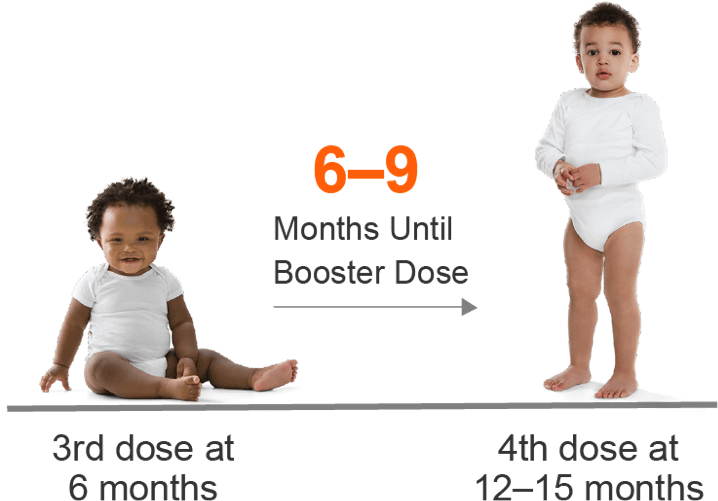IPD incidence in children in the US during the first year of life was >2x that of children 1-4 years of age, per a 2018-2021 pooled analysis7,a
IPD incidence in children in the US from a 2018-2021 pooled analysis7,a

aThe CDC’s ABC surveillance areas for Streptococcus pneumoniae included 10 states from 2018-2021, representing more than 34 million persons per year. During that period, there were 161 cases of IPD reported in infants less than 1 year of age, 134 cases in children 1 year of age, and 164 cases in children ages 2 to 4. Data for 2020 may have been impacted by associated mitigation measures implemented during the COVID-19 pandemic.7,15
VAXNEUVANCE is administered as a 4-dose series at 2, 4, 6, and 12 through 15 months of age.
Key effects of common IPD types

Pneumococcal Meningitis
- About 1 in 12 children die of the infection
- Survivors may have lifelong disabilities, such as hearing loss or other neurological complications17
Recommended PCV dosing
PCVs are recommended as a 4-dose series. Children wait 6-9 months after the third dose until they are able to receive the fourth dose.9

Learn about IPD vaccine disparities among children
cNIS-Child, a random digit-dialed telephone survey of parents/guardians of children aged 19–35 months that the CDC used to estimate the vaccination coverage with ACIP-recommended vaccines in the US among children born in 2019 and 2020.18
ABC, Active Bacterial Core; ACIP, Advisory Committee on Immunization Practices; CDC, Center for Disease Control and Prevention; IPD, invasive pneumococcal disease; NIS-Child, National Immunization Survey – Child; PCV, pneumococcal conjugate vaccine.

The immune response generated postdose 3 is an important measure when evaluating protection against IPD during the first year of life.2,5,9

Explore
immunogenicity

Assess immune response vs PCV13

Learn about specific
populations

Review CDC, AAP, and
AAFP recommendations
Reference
Reference
Reference
Reference
Reference
Reference
Reference
Reference
Reference
Reference
Reference
Reference
Reference
Reference
Indications and Usage for VAXNEUVANCE
VAXNEUVANCE is indicated for active immunization for the prevention of invasive disease caused by Streptococcus pneumoniae serotypes 1, 3, 4, 5, 6A, 6B, 7F, 9V, 14, 18C, 19A, 19F, 22F, 23F, and 33F in individuals 6 weeks of age and older.
Select Safety Information for VAXNEUVANCE
Do not administer VAXNEUVANCE to individuals with a severe allergic reaction (eg, anaphylaxis) to any component of VAXNEUVANCE or to diphtheria toxoid.
Some individuals with altered immunocompetence, including those receiving immunosuppressive therapy, may have a reduced immune response to VAXNEUVANCE.
Apnea following intramuscular vaccination has been observed in some infants born prematurely. Vaccination of premature infants should be based on the infant’s medical status and the potential benefits and possible risks.
The most commonly reported solicited adverse reactions in children vaccinated at 2, 4, 6, and 12 through 15 months of age, provided as a range across the 4-dose series, were: irritability (57.3% to 63.4%), somnolence (24.2% to 47.5%), injection-site pain (25.9% to 40.3%), fever ≥38.0°C (13.3% to 20.4%), decreased appetite (14.1% to 19.0%), injection-site induration (13.2% to 15.4%), injection-site erythema (13.7% to 21.4%), and injection-site swelling (11.3% to 13.4%).
The most commonly reported solicited adverse reactions in children 2 through 17 years of age vaccinated with a single dose were: injection-site pain (54.8%), myalgia (23.7%), injection-site swelling (20.9%), injection-site erythema (19.2%), fatigue (15.8%), headache (11.9%), and injection-site induration (6.8%).
The reported solicited adverse reactions in children 7 through 11 months of age who received 3 doses of VAXNEUVANCE were: fever ≥38.0°C (21.9%), irritability (32.8%), injection-site erythema (28.1%), somnolence (21.9%), injection-site swelling (18.8%), injection-site pain (18.8%), injection-site induration (17.2%), decreased appetite (15.6%), and urticaria (1.6%).
The reported solicited adverse reactions in children 12 through 23 months of age who received 2 doses of VAXNEUVANCE were: fever ≥38.0°C (11.3%), irritability (35.5%), injection-site pain (33.9%), somnolence (24.2%), decreased appetite (22.6%), injection-site erythema (21.0%), injection-site swelling (14.5%), and injection-site induration (8.1%).
Vaccination with VAXNEUVANCE may not protect all vaccine recipients.
Before administering VAXNEUVANCE, please read the accompanying Prescribing Information. The Patient Information also is available.
Indications and Usage for VAXNEUVANCE
VAXNEUVANCE is indicated for active immunization for the prevention of invasive disease caused by Streptococcus pneumoniae serotypes 1, 3, 4, 5, 6A, 6B, 7F, 9V, 14, 18C, 19A, 19F, 22F, 23F, and 33F in individuals 6 weeks of age and older.
VAXNEUVANCE is indicated for active immunization for the prevention of invasive disease caused by Streptococcus pneumoniae
VAXNEUVANCE is indicated for active immunization for the prevention of invasive disease caused by Streptococcus pneumoniae serotypes 1, 3, 4, 5, 6A, 6B, 7F, 9V, 14, 18C, 19A, 19F, 22F, 23F, and 33F in individuals 6 weeks of age and older.
Select Safety Information for VAXNEUVANCE
Do not administer VAXNEUVANCE to individuals with a severe allergic reaction (eg, anaphylaxis) to any component of VAXNEUVANCE or to diphtheria toxoid.
Some individuals with altered immunocompetence, including those receiving immunosuppressive therapy, may have a reduced immune response to VAXNEUVANCE.
Apnea following intramuscular vaccination has been observed in some infants born prematurely. Vaccination of premature infants should be based on the infant’s medical status and the potential benefits and possible risks.
The most commonly reported solicited adverse reactions in children vaccinated at 2, 4, 6, and 12 through 15 months of age, provided as a range across the 4-dose series, were: irritability (57.3% to 63.4%), somnolence (24.2% to 47.5%), injection-site pain (25.9% to 40.3%), fever ≥38.0°C (13.3% to 20.4%), decreased appetite (14.1% to 19.0%), injection-site induration (13.2% to 15.4%), injection-site erythema (13.7% to 21.4%), and injection-site swelling (11.3% to 13.4%).
The most commonly reported solicited adverse reactions in children 2 through 17 years of age vaccinated with a single dose were: injection-site pain (54.8%), myalgia (23.7%), injection-site swelling (20.9%), injection-site erythema (19.2%), fatigue (15.8%), headache (11.9%), and injection-site induration (6.8%).
The reported solicited adverse reactions in children 7 through 11 months of age who received 3 doses of VAXNEUVANCE were: fever ≥38.0°C (21.9%), irritability (32.8%), injection-site erythema (28.1%), somnolence (21.9%), injection-site swelling (18.8%), injection-site pain (18.8%), injection-site induration (17.2%), decreased appetite (15.6%), and urticaria (1.6%).
The reported solicited adverse reactions in children 12 through 23 months of age who received 2 doses of VAXNEUVANCE were: fever ≥38.0°C (11.3%), irritability (35.5%), injection-site pain (33.9%), somnolence (24.2%), decreased appetite (22.6%), injection-site erythema (21.0%), injection-site swelling (14.5%), and injection-site induration (8.1%).
Vaccination with VAXNEUVANCE may not protect all vaccine recipients.
Before administering VAXNEUVANCE, please read the accompanying Prescribing Information. The Patient Information also is available.
Do not administer VAXNEUVANCE to individuals with a severe allergic reaction (eg, anaphylaxis) to any component of VAXNEUVANCE or
Do not administer VAXNEUVANCE to individuals with a severe allergic reaction (eg, anaphylaxis) to any component of VAXNEUVANCE or to diphtheria toxoid.
Some individuals with altered immunocompetence, including those receiving immunosuppressive therapy, may have a reduced immune response to VAXNEUVANCE.



